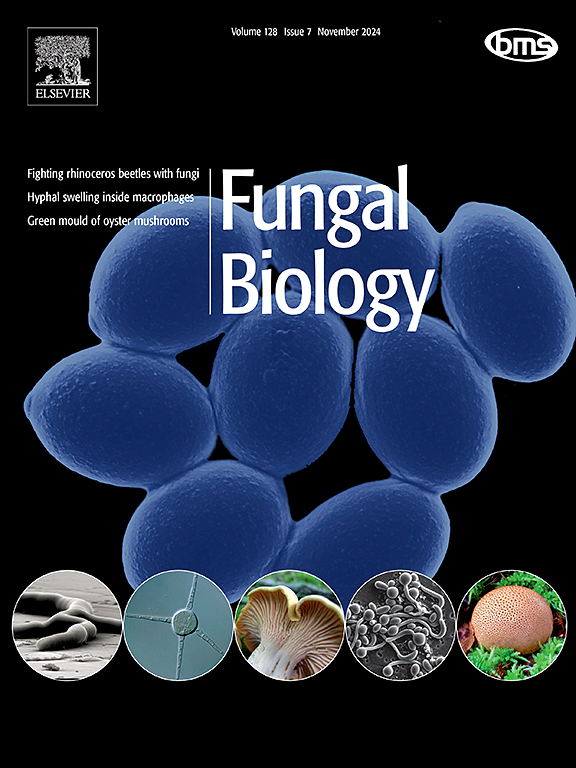The effects of climatic variability on the occurrence of Aspergillus species in commercial maize from different agro-climatic regions in South Africa
IF 3
3区 生物学
Q2 MYCOLOGY
引用次数: 0
Abstract
Most African research reports on the frequent aflatoxin contamination of various foodstuffs, with few reports giving details of the Aspergillus species present in these commodities. Numerous research works provide evidence of the ability of fungi to grow, thrive, and interact with other crop species and focus on the fact that these processes are largely affected by climatic variables. As opposed to the attention directed to the above-mentioned themes, information on the biodiversity of Aspergillus species in maize in most African countries, including South Africa, is lacking. This study on Aspergillus species in maize serves to close that gap in that it attempts to establish a comprehensive and most recent picture of the biodiversity of Aspergillus species in South African (SA) commercial maize across the respective climatic regions. Thus, it sets out to predict changes in the distribution of these fungal species, their contamination effects on maize variety as well as to identify and differentiate the aflatoxigenic Aspergillus strains from the non-aflatoxigenic ones under changing climate scenarios across the respective agro-climatic regions of South Africa. By applying molecular methods, a total of 1028 maize samples from six distinct agro-climatic regions, namely, Western Free State (WFS), Eastern Free State (EFS), Northern Free State (NFS), Southern Free State (SFS), North-West (NW), and Gauteng Province (GP) were examined for contamination by the Aspergillus species. About 29.67 % of the maize samples were contaminated by at least one of the eight Aspergillus species that were isolated in this study. Less than 30 % (28.95 %) of the 228 isolates subjected to the aflatoxigenic test was found to possess at least one of the aflatoxin biosynthetic genes. In all, the occurrence of the Aspergillus species (especially Aspergillus fumigatus) in SA commercial maize are significantly influenced (P < 0.0001) by maize variety, year of cultivation as well as the agro-climatic region in which the maize is cultivated.
气候变化对南非不同农业气候区商品玉米中曲霉种类发生的影响
大多数非洲研究报告了各种食品中常见的黄曲霉毒素污染,很少有报告详细说明这些商品中存在的曲霉种类。许多研究工作提供了真菌生长、茁壮成长和与其他作物物种相互作用的能力的证据,并关注这些过程在很大程度上受气候变量影响的事实。与对上述主题的注意相反,在包括南非在内的大多数非洲国家,缺乏关于玉米中曲霉物种的生物多样性的资料。这项关于玉米曲霉物种的研究有助于缩小这一差距,因为它试图建立一个全面和最新的南非(SA)商业玉米曲霉物种多样性的图片,跨越各自的气候区域。因此,它开始预测这些真菌物种的分布变化,它们对玉米品种的污染影响,以及在南非各自农业气候区域不断变化的气候情景下识别和区分产黄曲霉菌株和非产黄曲霉菌株。采用分子方法,对来自西部自由邦(WFS)、东部自由邦(EFS)、北部自由邦(NFS)、南部自由邦(SFS)、西北部(NW)和豪登省(GP) 6个不同农业气候区的1028份玉米样品进行了曲霉污染检测。约29.67%的玉米样品被本研究分离到的8种曲霉中的至少一种污染。在228株黄曲霉毒素试验中,发现含有至少一种黄曲霉毒素生物合成基因的菌株不到30%(28.95%)。综上所述,SA商品玉米中曲霉种类(尤其是烟曲霉)的发生受玉米品种、栽培年份以及玉米栽培的农业气候区的显著影响(P < 0.0001)。
本文章由计算机程序翻译,如有差异,请以英文原文为准。
求助全文
约1分钟内获得全文
求助全文
来源期刊

Fungal biology
MYCOLOGY-
CiteScore
5.80
自引率
4.00%
发文量
80
审稿时长
49 days
期刊介绍:
Fungal Biology publishes original contributions in all fields of basic and applied research involving fungi and fungus-like organisms (including oomycetes and slime moulds). Areas of investigation include biodeterioration, biotechnology, cell and developmental biology, ecology, evolution, genetics, geomycology, medical mycology, mutualistic interactions (including lichens and mycorrhizas), physiology, plant pathology, secondary metabolites, and taxonomy and systematics. Submissions on experimental methods are also welcomed. Priority is given to contributions likely to be of interest to a wide international audience.
 求助内容:
求助内容: 应助结果提醒方式:
应助结果提醒方式:


